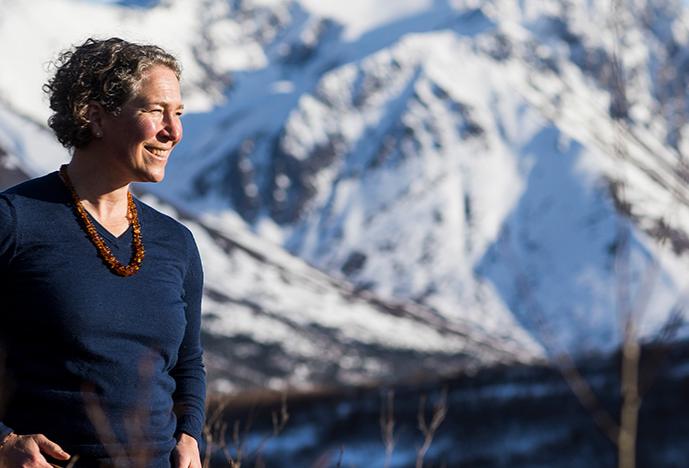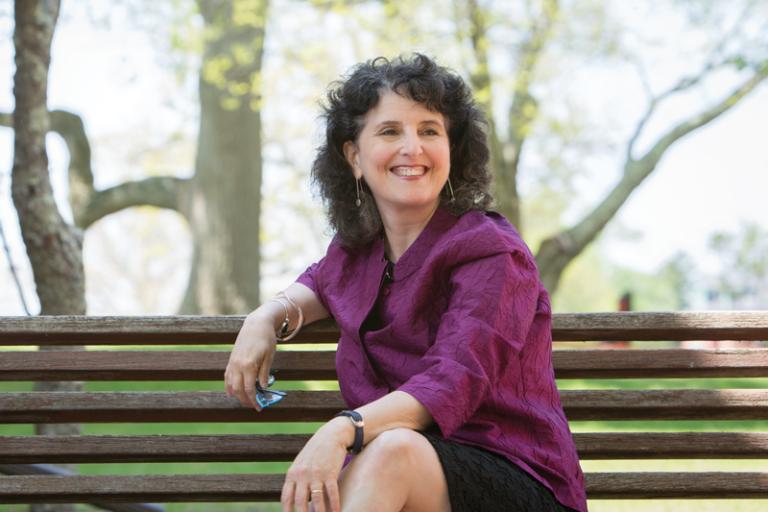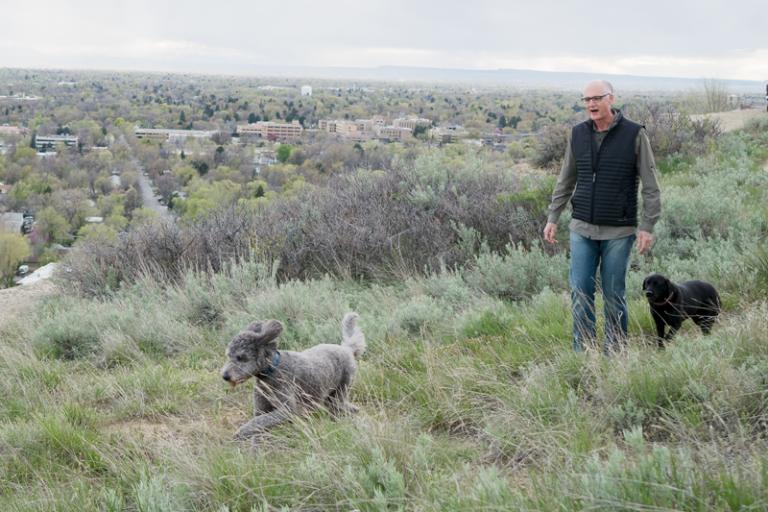In a Big Country
How doctors are tackling the health care disparities that challenge our nation’s rural residents
- 11 minute read
- Feature

Marna Schwartz
In every week, weather permitting, Marna Schwartz ’00 hops into a small plane and travels from her home in Juneau, Alaska, to spend a few days seeing patients in Alaska Native and non-native communities. Life in these villages is a stark contrast to the comparatively metropolitan Juneau. Populations range from 400 to 2,500; most are accessible only by boat or plane. One of the villages that Schwartz serves has a single store and no restaurants. But it does have a community health center.
“In this community, one of the nicest buildings is probably the clinic,” says Schwartz, a pediatrician with the Southeast Alaska Regional Health Consortium, “There’s going to be an x-ray machine and a little lab. It will have someone on call 24/7. The residents actually have pretty incredible access to care given the size of the community.”
As in most rural areas, there is a shortage of health care workers—only two of the seven communities Schwartz regularly visits have family practice doctors. Many clinics are instead staffed by nurse practitioners and physician assistants who can diagnose, treat, and prescribe on their own or by telephone or text-based consultations with physicians in larger communities. As in most rural areas, facilities like these are crucial.
Seventeen hundred miles away as the crow flies, Matthew Tobey spends a quarter of each year seeing patients on the Rosebud Indian Reservation in southern South Dakota, an ocean of hills and grasslands that is around one-and-a-half times the size of Rhode Island and home to roughly 10,000 people. Tobey, an HMS instructor in medicine at Massachusetts General Hospital, is also associate program director of the hospital’s Rural Health Leadership Fellowship program.
Last summer, the thirty five-bed Indian Health Service hospital in Rosebud reopened its emergency room, which had been shuttered by the federal government owing to safety and staffing issues. The restoral brought much-needed relief for residents, who for months had traveled around 50 miles to get to one of two hospitals with emergency services. Hard on the heels of that relief, however, came new losses. A key clinician died, and maintenance problems and a nursing shortage forced the Rosebud hospital to close its surgery and obstetrics departments. The clinician position has yet to be filled, and the operating rooms remain closed.
Communities like those that Schwartz and Tobey serve are not simply isolated—they are underresourced.
“As soon as you fix one problem, two or three more crop up.” Tobey says. “There just aren’t enough human or financial resources to keep everything under control.”
The Rosebud reservation spans some of the poorest counties in the nation. Eighty-three percent of tribal members are unemployed, while in the counties the reservation covers almost half of all residents live below the federal poverty level and one in six people are uninsured. Mortality rates for cardiovascular diseases, cancer, injury, suicide, and substance abuse are all significantly higher than U.S. averages. All told, life expectancy is nearly equivalent to that found in North Korea.
Permutations of this story of health disparities can be found throughout the land. Residents of remote or sparsely populated rural communities appear to be worse off than those in urban areas in almost every major statistical measure of health. People who live in rural areas have higher mortality rates in each of the leading causes of death in the United States: cancer, heart disease, unintentional injury, stroke, and chronic respiratory disease. They are more likely to abuse alcohol and other substances, use tobacco, be obese, be uninsured, and commit suicide.
There is no single explanation for this chasm. Wealth is the strongest predictor of life expectancy and is tethered to access to health care and education and to behaviors and other social factors, each of which is also independently associated with health outcomes. These social factors reflect universal challenges—the struggle for economic opportunity, for fair treatment, for hope for the future. But people living in rural regions of the United States, despite their vastly different histories and cultures, economies and geographies, share the common burden of isolation. Geographically, economically, and socially removed from urban centers that produce and consume the vast majority of the nation’s resources, those who live in rural areas face additional barriers that make these challenges even more burdensome.

Going It Alone
Under the broadest definition, only 3 percent of the nation’s total land area is inhabited by enough residents—at least 2,500 on a given tract of land—to be designated as an urban area or cluster by the U.S. Census Bureau. What falls outside this official definition—a mosaic of plains and mountains, coastline and desert, forests and swamps that together span an area almost the size of China—is homogeneously dubbed rural.
About one in every five people who live in the United States reside in rural parts of the country. Yet, a little more than a century ago, more than half of the U.S. population lived in rural areas. This population shift has coincided with, and been driven by, decades of sweeping social, economic, and technological upheavals that have increasingly concentrated financial and human capital in urban centers and amplified the isolation of rural communities.
The effects of this isolation on health care extend beyond proximity to facilities; they also affect access to specialty services.
There are almost nine times as many specialists per capita in urban areas as there are in rural areas. As a pediatrician, Schwartz primarily serves as a consultant, offering much-needed advice and support to local providers. But complex cases must be referred to better-resourced hospitals, often in Anchorage or Juneau. For patients and their families, the time and resources needed for travel can influence their decisions on whether to pursue medical care.
“If your child has a complex behavioral, neurodevelopmental, or motor, speech, or social delay, but you don’t have local access to services for such conditions,” says Schwartz, “you may wonder why you should put a lot of effort into getting a diagnosis. If accessing a specialist means a small plane ride, a jet trip, two overnight stays, patients may choose to rely on nonspecialists who provide care in their community.”
A World of Pain
Distance to specialty care services can have wide-reaching consequences, particularly for chronic conditions such as depression or bipolar disorder. Regardless of location, the prevalence of mental health disorders is similar across the United States. Yet, around 90 percent of psychologists and psychiatrists and 80 percent of clinical social workers are based in urban areas. More than half of rural counties have no practicing mental health professionals.
“Mental health conditions require consistent follow-up,” says Shelly Greenfield ’86, an HMS professor of psychiatry and chief academic officer at McLean Hospital. “Patients may need to see somebody weekly for some forms of treatment, and if in the acute phase, almost daily in some instances. You can see immediately the problem for rural residents. It’s not a new phenomenon. I think, however, that the escalated prevalence of opioid use disorders has shined a light on this disparity.”
An estimated 2.5 million adults in the United States struggle with addiction to opioid drugs, including prescription painkillers and heroin. Opioid-related overdoses caused more than 33,000 deaths in 2015—nearly equal to fatalities from traffic accidents—and rural areas have been hit especially hard. In West Virginia, home to the highest opioid overdose rate in the country, drug companies shipped some 780 million doses of opioids to the state between 2007 and 2012. A single pharmacy in the town of Kermit, with a population under 400, received nearly 9 million doses of hydrocodone over a two-year period.
Around half of those who abuse drugs also meet the criteria for a mental health illness. Although numerous factors, including genetics, environment, and personal trauma are also involved, people with disorders such as depression or anxiety are at greater risk for substance use, which can escalate if left untreated, says Greenfield. In rural communities that struggle with poverty, that have a labor force engaged in work that carries the risk of physical injury, and that harbor social and cultural circumstances that can foster substance abuse disorders, the overabundance of opioids and lack of access to care have been devastating.
“Effective treatments, including medications and behavioral treatments, for all of these disorders exist,” says Greenfield, “There’s nothing magical about it. When there’s an effective treatment available for an illness, but whole populations can’t receive it because we can’t bring that treatment closer to them, then there’s something wrong with the system of care.”
There are promising efforts to bridge this gap, including free transport programs, better and more culturally appropriate training for mental health workers, and telemedicine—both physician-to-patient and physician-to-physician—to give rural providers immediate access to specialists. Addressing distance barriers then leaves economic ones: the ability to pay or to be reimbursed for treatments.
In 2010, the passage of the Patient Protection and Affordable Care Act launched various federal initiatives aimed at improving health care nationwide, including expanding mental health and substance abuse coverage. One of the more significant provisions for rural communities has been the expansion of Medicaid, which extended health care coverage to millions of previously ineligible low-income people. Although the overall outcomes are yet to be determined, some studies show that in states that accepted Medicaid expansion, rural hospitals and clinics saw an increase in revenue and improved chances of being profitable, both key to staying open.

The Feathers of Hope
Insurance coverage may also provide low-income communities with more than just access to treatment. Work from the National Bureau of Economic Research, which is tracking the outcomes of individuals since the inception of Medicaid more than 50 years ago, suggests that young children from low-income backgrounds who were covered by the program had healthier and longer lives than peers without coverage. As adults, they had lower rates of mortality, including deaths related to cardiovascular disease, cancer, and suicide; were less likely to be disabled or on public assistance; and were more likely to be better educated and have higher-paying jobs.
“Early childhood access to health insurance is potentially a social factor that can change the life trajectory of an individual,” says Atheendar Venkataramani, a health economist and an HMS assistant professor of medicine at Mass General, who studies the health consequences of economic opportunity—the prospect for future social mobility.
The mechanisms linking health insurance access to long-term well-being are not well understood. It’s possible that financial support from programs such as Medicaid allows families to spend more on nutrition, education, and in other developmentally beneficial ways. After all, wealth leads to health—life expectancy can vary by more than 20 years between the richest and poorest counties in the United States. But Venkataramani has found that economic opportunity—optimism for higher-paying jobs or lower stress as a result of not needing to worry about access to health care, for example—may play a similarly important role. His recent research found that U.S. counties with higher economic opportunity levels have significantly lower mortality rates.
“My personal belief is that hope, motivation, and aspirations count for a lot in health,” says Venkataramani. “If you think there’s a strong economic future for you, the returns on investing in your health rise. You need to be healthy to take advantage of those opportunities. What I see in the clinic is that people who are hopeful about their future tend to take positive steps for their health, and the people who aren’t are less motivated to do so.”
The Human Community
In a recent set of much-debated papers, Nobel Laureate Angus Deaton and Anne Case, both economists at Princeton University, found midlife mortality rates in this country were rising dramatically for non-college educated whites even as mortality fell among other groups. Their findings, they speculate, reflect “deaths of despair,” those from drug and alcohol abuse and suicide which smolder then ignite as job prospects and a cherished way of life dry up.
“The types of communities that people come from have a much more profound effect on their health, on their thinking, than anything a clinician does in a given visit,” Venkataramani says.
The hope and despair that attend the problems of rural health and care stem from the deeply interconnected concerns that touch every facet of life—social, economic, cultural, political, medical, historical. There is no single solution to the disparities between rural and urban health in this country, for there is no single cause. Yet those who deliver care to rural populations and those who conceive of, implement, and assess programs designed to chip away at the disparities so often fueled by isolation show no signs of giving up.
Just ask Phillip Key ’88, an ear, nose, and throat specialist in Billings, Montana, the state’s major metropolitan hub and its only city with a population over 100,000. When Key moved from Los Angeles to Billings, he found that he had to change the way he practiced medicine: he had to better understand his patients’ lives in order to effectively treat them.
“When I drilled down,” says Key, “I would find that a significant proportion of them would have other issues going on. Developing a relationship was vital.”
“The thing I like about Billings,” he adds, “is that the people I treat are my neighbors; we have very few degrees of separation. They’re way more neighbors than they are patients.”
“It’s not that I’ve felt I wasn’t accountable elsewhere,” he says. “But it’s a different accountability when you see people you’ve operated on, whose mom you’ve operated on, whose daughter you’ve cared for. You know those patients. And they know you.”
Images: Nathaniel Wilder (top); John Soares (Greenfield); Paul Bellinger (Key)